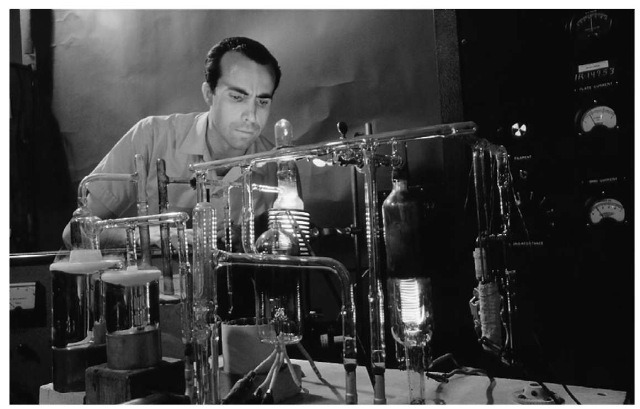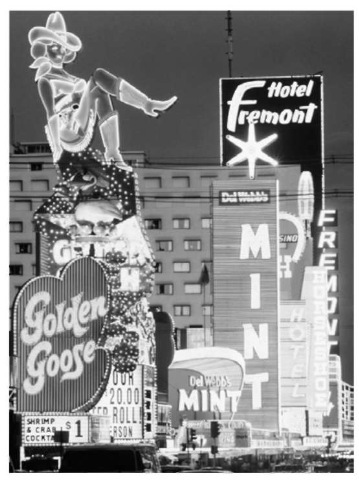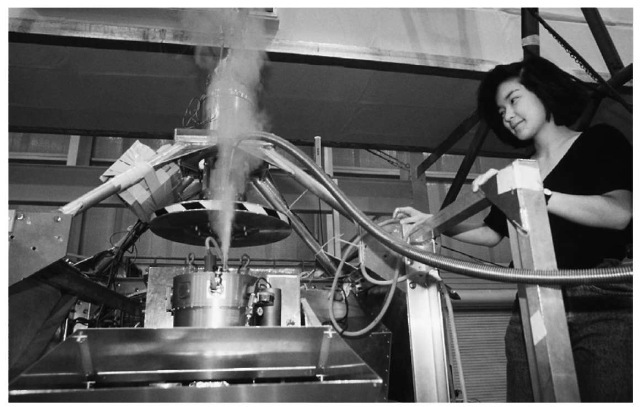Concept
Along the extreme right-hand column of the periodic table of elements is a group known as the noble gases: helium, neon, argon, krypton, xenon, and radon. Also known as the rare gases, they once were called inert gases, because scientists believed them incapable of reacting with other elements. Rare though they are, these gases are a part of everyday life, as evidenced by the helium in balloons, the neon in signs—and the harmful radon in some American homes.
How it works
Defining the Noble Gases
The periodic table of elements is ordered by the number of protons in the nucleus of an atom for a given element (the atomic number), yet the chart is also arranged in such a way that elements with similar characteristics are grouped together. Such is the case with Group 8, which is sometimes called Group 18, a collection of non-metals known as the noble gases. The six noble gases are helium (He), neon (Ne), argon (Ar), krypton (Kr), xenon (Xe), and radon (Rn). Their atomic numbers are, respectively, 2, 10, 18, 36, 54, and 86.
Several characteristics, aside from their placement on the periodic table, define the noble gases. Obviously, all are gases, meaning that they only form liquids or solids at extremely low temperatures—temperatures that, on Earth at least, are usually only achieved in a laboratory. They are colorless, odorless, and tasteless, as well as monatomic—meaning that they exist as individual atoms, rather than in molecules. (By contrast,atoms of oxygen—another gas, though not among this group—usually combine to form a molecule, O2.)
Low Reactivity
There is a reason why noble gas atoms tend not to combine: one of the defining characteristics of the noble gas “family” is their lack of chemical reactivity. Rather than reacting to, or bonding with, other elements, the noble gases tend to remain apart—hence the name “noble,” implying someone or something that is set apart from the crowd, as it were. Due to their apparent lack of reactivity, the noble gases—also known as the rare gases—were once known as the inert gases.
Indeed, helium, neon, and argon have not been found to combine with other elements to form compounds. However, in 1962 English chemist Bartlett (1932-) succeeded in preparing a compound of xenon with platinum and fluorine (XePtF6), thus overturning the idea that the noble gases were entirely “inert.” Since that time, numerous compounds of xenon with other elements, most notably oxygen and fluorine, have been developed. Fluorine has also been used to form simple compounds with krypton and radon.
Nonetheless, low reactivity—instead of no reactivity, as had formerly been thought—characterizes the rare gases. One of the factors governing the reactivity of an element is its electron configuration, and the electrons of the noble gases are arranged in such a way as to discourage bonding with other elements.

A scientist using the potassium-argon dating process to determine the age of materials .
Real-Life Applications
Isolation of the Noble Gases
Helium
Helium is an unusual element in many respects—not least because it is the only element to have first been identified in the Solar System before it was discovered on Earth. This is significant, because the elements on Earth are the same as those found in space: thus, it is more than just an attempt at sounding poetic when scientists say that humans, as well as the world around them, are made from “the stuff of stars.”
In 1868, a French astronomer named Pierre Janssen (1824-1907) was in India to observe a total solar eclipse. To aid him in his observations, he used a spectroscope, an instrument for analyzing the spectrum oflight emitted by an object. What Janssen’s spectroscope showed was surprising: a yellow line in the spectrum, never seen before, which seemed to indicate the presence of a previously undiscovered element. Janssen called it “helium” after the Greek god Helios, or Apollo, whom the ancients associated with the Sun.
Janssen shared his findings with English astronomer Sir Joseph Lockyer (1836-1920), who had a worldwide reputation for his work in analyzing light waves. Lockyer, too, believed that what Janssen had seen was a new element, and a few months later, he observed the same unusual spectral lines. At that time, the spectroscope was still a new invention, and many members of the worldwide scientific community doubted its usefulness, and therefore, in spite of Lockyer’s reputation, they questioned the existence of this “new” element. Yet during their lifetimes, Janssen and Lockyer were proven correct.
Neon, argon, krypton,and xenon
They had to wait a quarter century, however. In 1893, English chemist Sir William Ramsay (1852-1916) became intrigued by the presence of a mysterious gas bubble left over when nitrogen from the atmosphere was combined with oxygen. This was a phenomenon that had also been noted by English physicist Henry Cavendish (1731-1810) more than a century before, but Cavendish could offer no explanation. Ramsay, on the other hand, had the benefit of observations made by English physicist John William Strutt, Lord Rayleigh (1842-1919).
Up to that time, scientists believed that air consisted only of oxygen, carbon dioxide, and water vapor. However, Rayleigh had noticed that when nitrogen was extracted from air after a process of removing those other components, it had a slightly higher density than nitrogen prepared from a chemical reaction. In light of his own observations, Ramsay concluded that whereas nitrogen obtained from chemical reactions was pure, the nitrogen extracted from air contained trace amounts of an unknown gas.
Ramsay was wrong in only one respect: hidden with the nitrogen was not one gas, but five. In order to isolate these gases, Ramsay and Rayleigh subjected air to a combination of high pressure and low temperature, allowing the various gases to boil off at different temperatures. One of the gases was helium—the first confirmation that the element existed on Earth—but the other four gases were previously unknown. The Greek roots of the names given to the four gases reflected scientists’ wonder at discovering these hard-to-find elements: neos (new), argos (inactive), kryptos (hidden), and xenon (stranger).
Radon
Inspired by the studies of Polish-French physicist and chemist Marie Curie (1867-1934) regarding the element radium and the phenomenon of radioactivity (she discovered the element, and coined the latter term), German physicist Friedrich Dorn (1848-1916) became fascinated with radium. Studying the element, he discovered that it emitted a radioactive gas, which he dubbed “radium emanation.” Eventually, however, he realized that what was being produced was a new element. This was the first clear proof that one element could become another through the process of radioactive decay.
Ramsay, who along with Rayleigh had received the Nobel Prize in 1904 for his work on the noble gases, was able to map the new element’s spectral lines and determine its density and atomic mass. A few years later, in 1918, another scientist named C. Schmidt gave it the name “radon.” Due to its behavior and the configuration of its electrons, chemists classified radon among what they continued to call the “inert gases” for another half-century—until Bartlett’s preparation of xenon compounds in 1962.
Presence of the Rare Gases on Earth
In the atmosphere.
Though the rare gases are found in minerals and meteorites on Earth, their greatest presence is in the planet’s atmosphere. It is believed that they were

Las Vegas has numerous examples of signs illuminated by neon.
released into the air long ago as a by-product of decay on the part of radioactive materials in the Earth’s crust. Within the atmosphere, argon is the most “abundant”—in comparative terms, given the fact that the “rare gases” are, by definition, rare.
Nitrogen makes up about 78% of Earth’s atmosphere and oxygen 21%, meaning that these two elements constitute fully 99% of the air above the Earth. Argon ranks a distant third, with 0.93%. The remaining 0.07% is made up on water vapor, carbon dioxide, ozone (O3), and traces of the noble gases. These are present in such small quantities that the figures for them are not typically presented as percentages, but rather in terms of parts per million (ppm). The concentrations of neon, helium, krypton, and xenon in the atmosphere are 18, 5, 1, and 0.09 ppm respectively.
in the soil. Radon in the atmosphere is virtually negligible, which is a fortunate thing, in light of its radioactive qualities. Few Americans, in fact, even knew of its existence until 1988, when the United States Environmental Protection Agency (EPA) released a report estimating that some ten million American homes had potentially harmful radon levels. This

A researcher works with liquid helium as part of an experiment on cosmic background radiation. Close to absolute zero, helium transforms into a highly unusual liquid that has no measurable resistance to flow.
set off a scare, and during the late 1980s and 1990s, sales of home radon detectors boomed. Meanwhile, the federal government increased concerns with additional reports, advising people to seal their basements and ventilate their homes if radon exceeded certain levels.
A number of scientists have disputed the government’s claims, yet some regions of the United States appear to be at relatively high risk due to the presence of radon in the soil. The element seems to be most plentiful in soils containing high concentrations of uranium. If radon is present in a home that has been weather-sealed to improve the efficiency of heating and cooling systems, it is indeed potentially dangerous to the residents.
Chinese scientists in the 1960s made an interesting discovery regarding radon and its application to seismography, or the area of the earth sciences devoted to studying and predicting earthquakes. Radon levels in groundwater, the Chinese reports showed, rise considerably just before an earthquake. Since then, the Chinese have monitored radon concentrations in water, and used this data to predict earthquakes.
Extracting rare gases
Radon, in fact, is not the only rare gas that can be obtained as the result of radioactive decay: in 1903, Ramsay and British chemist Frederick Soddy (1877-1956) showed that the breakdown of either uranium or radium results in the production of helium atoms (beta particles). A few years later, English physicist Ernest Rutherford (1871-1937) demonstrated that radiation carrying a positive electrical charge (alpha rays) was actually a stream of helium atoms stripped of an electron.
Many of the noble gases are extracted by liquefying air—that is, by reducing it to temperatures at which it assumes the properties of a liquid rather than a gas. By controlling temperatures in the liquefied air, it is possible to reach the boiling point for a particular noble gas and thereby extract it, much as was done when these gases were first isolated in the 1890s.
The unique situation of helium
Helium is remarkable, in that it only liquefies at a temperature of -457.6°F (-272°C), just above absolute zero. Absolute zero is the temperature at which the motion of atoms or molecules comes to a virtual stop, but the motion of helium atoms never completely ceases. In order to liquefy it, in fact, even at those low temperatures, it must be subjected to pressures many times that exerted by Earth’s atmosphere.
Given these facts, it is difficult to extract helium from air. More often, it is obtained from natural gas wells, where it is present in relatively large concentrations—between 1% and 7% of the natural gas. The majority of the Earth’s helium supply belongs to the United States, where the greatest abundance of helium-supplying wells are in Texas, Oklahoma, and Kansas. During World War II, the United States took advantage of this supply of relatively inexpensive helium to provide buoyancy for a fleet of airships used for reconnaissance.
There is one place with an abundant supply of helium, but there are no plans for a mining expedition any time soon. That place is the Sun, where the nuclear fusion of hydrogen atoms creates helium. Indeed, helium seems to be the most plentiful element of all, after hydrogen, constituting 23% of the total mass of the universe. Why, then, is it so difficult to obtain on Earth? Most likely because it is so light in comparison to air; it simply floats off into space.
Applications for the Noble Gases
Radon, argon, krypton,and xenon
Though radon is known primarily for the hazards it poses to human life and well-being, it has useful applications. As noted above, its presence in groundwater appears to provide a possible means of predicting earthquakes. In addition, it is used for detecting leaks, measuring flow rates, and inspecting metal welds.
One interesting use of argon and, in particular, the stable isotope argon-40, is in dating techniques used by geologists, paleontologists, and other scientists studying the distant past. When volcanic rocks are subjected to extremely high temperatures, they release argon, and as the rocks cool, argon-40 accumulates. Because argon-40 is formed by the radioactive decay of a potassium isotope, potassium-40, the amount of argon-40 that forms is proportional to the rate of decay for potassium-40. The latter has a half-life of 1.3 billion years, meaning that it takes 1.3 billion years for half the potassium-40 originally present to be converted to argon-40. Using argon-40, paleontologists have been able to estimate the age of volcanic layers above and below fossil and artifact remains in east Africa.
Krypton has a number of specialized applications—for instance, it is mixed with argon and used in the manufacture of windows with a high level of thermal efficiency. Used in lasers, it is often mixed with a halogen such as fluorine. In addition, it is also sometimes used in halogen sealed-beam headlights. Many fans of Superman, no doubt, were disappointed at some point in their lives to discover that there is no such thing as “kryptonite,” the fictional element that caused the Man of Steel to lose his legendary strength. Yet krypton—the real thing—has applications that are literally out of this world. In the development of fuel for space exploration, krypton is in competition with its sister element, xenon. Xenon offers better performance, but costs about ten times more to produce; thus krypton has become more attractive as a fuel for space flight.
In addition to its potential as a space fuel, xenon is used in arc lamps for motion-picture film projection, in high-pressure ultraviolet radiation lamps, and in specialized flashbulbs used by photographers. One particular isotope of xenon is utilized for tracing the movement of sands along a coastline. Xenon is also applied in high-energy physics for detecting nuclear radiation in bubble chambers. Furthermore, neuroscientists are experimenting with the use of xenon in diagnostic procedures to clarify x-ray images of the human brain.
Neon
Neon, of course, is best-known for its application in neon signs, which produce an eye-catching glow when lit up at night. French chemist Georges Claude (1870-1960), intrigued by Ramsay’s discovery of neon, conducted experiments that led to the development of the neon light in 1910. That first neon light was simply a glass tube filled with neon gas, which glowed a bright red when charged with electricity.
Claude eventually discovered that mixing other gases with neon produced different colors of light. He also experimented with variations in the shapes of glass tubes to create letters and pictures. By the 1920s, neon light had come into vogue, and it is still popular today. Modern neon lamps are typically made of plastic rather than glass, and the range of colors is much greater than in Claude’s day: not only the gas filling, but the coating inside the tube, is varied, resulting in a variety of colors from across the spectrum.
Though the neon sign is its best-known application, neon is used for many other things. Neon glow lamps are often used to indicate on/off settings on electronic instrument panels, and lightweight neon lamps are found on machines ranging from computers to voltage regulators. In fact, the first practical color television, produced in 1928, used a neon tube to produce the red color in the receiver. Green came from mercury, but the blue light in that early color TV came from another noble gas, helium.
Helium
Helium, of course, is widely known for its use in balloons—both for large airships and for the balloons that have provided joy and fun to many a small child. Though helium is much more expensive than hydrogen as a means of providing buoyancy to airships, hydrogen is extremely flammable, and after the infamous explosion of the airship Hindenburg in 1937, helium became the preferred medium for airships. As noted earlier, the United States military made extensive use of helium-filled airships during the World War II.
The use of helium for buoyancy is one of the most prominent applications of this noble gas, but far from the only one. In fact, not only have people used helium to go up in balloons, but divers use helium for going down beneath the surface of the ocean. In that situation, of course, helium is not used for providing buoyancy, but as a means of protecting against the diving-related condition known as “the bends,” which occurs when nitrogen in the blood bubbles as the diver rises to the surface. Helium is mixed with oxygen in diver’s air tanks because it does not dissolve in the blood as easily as nitrogen.
Among the most fascinating applications of helium relate to its extraordinarily low freezing point. Helium has played a significant role in the low-temperature science known as cryogenics, and has found application in research concerning superconductivity: the use of very low temperatures to develop materials that conduct electrical power with vastly greater efficiency than ordinary conductors. Close to absolute zero, helium transforms into a highly unusual liquid unlike any known substance, in that it has no measurable resistance to flow. This means that it could carry an electrical current hundreds of times more efficiently than a copper wire.
